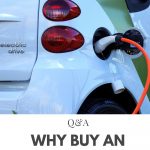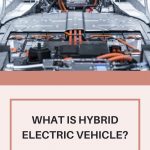Range Extended Electric Vehicle
Topic: Range Extended Electric Vehicle


Range Extended Electric Vehicle
The range anxiety that many electric car owners have can be alleviated by longer-range vehicles. Reduced fuel expenditures and increased vehicle and employee utilisation are benefits of fleet managers and drivers using range-extended electric cars.
Traditional internal combustion engine (ICE) automobiles are being phased out to favour the next generation of electric vehicles (EVs). The electric motor of an EV is powered by a battery that stores electric charge.
The usage of fossil fuels is reduced or eliminated with electric vehicles, which reduces our reliance on foreign oil and, in turn, our contribution to climate change.
They are more efficient at converting energy into motion since they use less gasoline than a regular vehicle. There are several advantages to driving an electric car instead of a gasoline-powered vehicle.
Electric vehicles have a lower energy cost per mile. Off-peak charging at night is less expensive than charging during the day. Reduced use of fossil fuels and thus lower carbon dioxide emissions are two of the primary benefits of electric vehicles (EVs).
Electric automobiles use less energy and produce less waste heat than gasoline-powered vehicles over the same distance. Fleets can use solar and other large-scale renewable energy charging technologies.
Please continue reading to discover how telematics solutions may help you get the most from your electric-car investment.
Vehicles powered by electricity and their ranges.
For the most part, an ICE vehicle’s range is roughly 300 miles. In turn, buyers anticipate that electric vehicles will have a close range when they get on the market. Today, the typical EV can travel 250 miles before needing a recharge. Customers’ need for a close-range drives EV manufacturers to improve their products.
Managing a fleet of electric vehicles can be a challenge for fleet managers because of “range anxiety.” When the EV battery is low and few charging outlets nearby, this occurs. Range anxiety stems from the worry that one could be trapped in a car without electricity or access to a charging station.
The EV’s range can also be affected by variables beyond its control. For example, a driver’s EV’s usable range may be reduced if it is really cold outside. EV fleet drivers may also feel confined in their trip distance if their vehicles lack range autonomy, which allows them to go larger distances.
However, recent advancements in electric vehicle design and technology have made it possible for vehicles to have longer ranges. This contributes to addressing the limited range of first-generation electric vehicles. The battery pack may now be recharged while the car is moving, in addition to just plugging it in while the engine is off.
What exactly are long-distance cars?
New technologies are boosting the driving range of current electric vehicles. The industry is employing several strategies to increase the electric vehicle’s range. An auxiliary power unit (APU) is commonly used to charge the battery pack in an extended-range electric vehicle (E-REV).
Plug-in hybrid cars are another name for these E-REVs.
The APU uses a tiny internal combustion engine to recharge the electric vehicle’s primary battery. Fuel is supplied via a 5-10 litre tank on this little engine. The APU’s output power will either meet or surpass the battery’s output power.
If the APU is less powerful than the battery capacity, the battery will continue to drain. Micro gas turbines are the most frequent type of APU. Despite its low power output, a normal EV battery pack may be charged with this device.
The APU performs battery charging while the vehicle is in motion when the battery charge capacity falls below a predefined low threshold (5-10 per cent). No driver interaction is required for this recharge.
It eliminates the need for extensive charging times or the instant need to find a charging station because of the additional APU charging. This essentially increases the EV’s range, allowing it to go further.
Various acronyms refer to a vehicle equipped with a range extender. These are the most commonly used acronyms for a mostly identical function:
Longer Range Electric Vehicles (LREV)
- A vehicle with a longer range than a standard electric vehicle is called a REEV.
- A battery electric vehicle with a range extender (BEVx).
- E-REV: An Electric Vehicle with a Greater Range
- Batteries can be charged via the grid or a range extender in a Plug-in Hybrid Electric Vehicle (PHEV).
4 advantages of long-range electric vehicles
- Managing a fleet of EVs can be more efficient than managing a fleet of similar ICE vehicles if the vehicles have a long enough range. This allows each EV to go greater distances without worrying about mid-day recharging.
- Your fleet may gain many advantages by using the APU to recharge the EV. Fleet managers will benefit from longer ranges. Longer travels will be easier with the advent of more electric automobiles.
- More travels on a single charge will also become possible for vehicles. Managers will have more alternatives for vehicle deployments now that they have additional route possibilities. For fleets, range extender technology provides the following advantages:
- There is less worry about getting stuck without an EV charge while driving a vehicle with a greater range. It is just a matter of time before electric vehicles with extenders can match or even exceed the range of a normal gasoline-powered vehicle.
Having the ability to operate independently is made possible by an increased vehicle range. Drivers with fewer restrictions can cover longer distances.
An EV with a longer range owing to an extender will allow for additional assignments to maximise the vehicle and crew utilisation, resulting in greater productivity. A vehicle’s efficiency may be influenced by how it is driven.
Refuelling an APU tank is far less expensive than that of a standard ICE car, even though the extender in the EV utilises conventional filling. Since power is used to charge the EV battery, the need for refuelling will be less frequent.
The main selling point for electric vehicles will undoubtedly continue to be their extended range. The range has been a significant selling feature for several manufacturers.
Premium luxury versions with higher power output are more common among other EV manufacturers. A vehicle fleet’s demands will determine the relative merits of each option.
Range Extended Electric Vehicle
Prepare yourselves for the return of the extender.
Few manufacturers have used range extenders in mass-produced vehicles other than the Opel Ampera and BMW i3, both hybrids. However, when a new generation of clean range extenders becomes available, prospects arise with entirely electric platforms.
As a result, electric vehicles (EVs) will continue to qualify as zero-emission vehicles even if used as a backup to vehicles powered by internal combustion engines (ICEs).
As a Tier 1 supplier to the industry’s leading automakers, Bosal is a family-owned firm that has been around for over a century. The company’s headquarters are in Belgium, although it has production and R&D facilities worldwide.
It expects the market for range extenders, such as tiny gas turbines and solid-oxide fuel cells (SOFCs), to rise as manufacturers seek to alleviate range anxiety without breaking the budget.
When these modern range extenders are coupled with an EV chassis, the resultant powertrain is substantially different from a few years ago. Zero-emission vehicles like the Ampera and i3 can run on battery power for up to 50 miles before switching to an internal combustion engine (ICE) generator.
Although these vehicles were powered by an electric motor, the energy they used was generated by an internal combustion engine (ICE), which emitted carbon dioxide during operation. These range extenders had a brief lifespan and were quickly phased out.
When range extenders originally appeared, they were built on ICE platforms. Still, today they’re being built on EV platforms.” According to Bosal Vice President of Technology Ted Straten, “this implies the car’s construction is fundamentally different.
An ICE extension would not fit.” The electric vehicle platform is the target of our range extenders.” As a result, they’re small, light, and packed with power, all at a low price.
On the other hand, a typical range extender requires a costly after-treatment system and many moving components, he explains. They are also easy to create and incorporate.
Straten feels the technology has reached a new phase with “huge prospects” for EV platforms following the “failed success” of early range extender powertrains.
Cut costs and increase the range.
It is increasingly common for electric vehicles to have significantly greater ranges than most people’s daily or weekly needs. The worry of running out of battery on extended excursions is the driving force behind the need for a range extender.
As a result, a more compact battery pack may be employed to accommodate daily commutes of lesser distances. While on vacation or business, a range extender may be charged up and utilised to provide an extra boost of range.
As a result, the range extender is only used when necessary. To put this in perspective, the overall electric vehicle platform is lighter and more cost-effective than before.
According to Straten, most European passenger vehicles drive fewer than 75 miles each day. Why would you put in a battery pack that can go 400, 500, or even 600 kilometres with this in mind, he asks emphatically?
That greater range costs money, and he’s worried it might hurt EV sales, especially in the entry-level categories where battery-electric models are more expensive than their gasoline or diesel counterparts.
It’s possible to buy a compact automobile for €10,000 (US $11,815), but if you convert it to an electric vehicle, it might sell for approximately €20,000. There will be an increase in the cost of smaller mass-market automobiles, which we want to prevent.
Range extenders are cheaper than larger battery packs, and long-distance driving may still be supported in terms of cost. Adding a range extender to an electric vehicle can put it on a level with a gasoline or diesel vehicle.
According to Bosal, the battery pack size may be lowered by up to a quarter in some applications, including compact city automobiles, potentially saving the manufacturer anywhere from €6,000 to €7,000 on the retail price of a vehicle.
In addition, Straten emphasises that the vehicle’s typical 400-kilometre range can be accommodated in the design. “The battery will be used for the first 150 kilometres, and the range extender will be used for the last 250 kilometres if necessary.
Hydrogen or any other alternative fuel may be pumped into the vehicle in the same way you would with a conventional car.”
A wide range of uses
Bosal has created two range extenders that may be used in a wide range of vehicles. The SOFC range extender may better serve larger passenger cars and heavy-duty trucks, whilst the tiny gas turbine may better serve smaller automobiles.
Despite its small size and low cost, “the micro gas turbine has a lower efficiency of roughly 30 per cent,” says Straten. As a result, only 30% of the energy used is utilised for propulsion, with the other 70% being wasted mostly as heat and friction.
He says, “But in the passenger car category, most drivers will utilise the EV battery first, and only use the range extender infrequently, which doesn’t necessitate great efficiency..”
With bigger trucks, efficiency is critical. Because of this, the cost of a range extender for certain applications will be a little higher, but this is acceptable to achieve improved energy efficiency.
As Straten points out, “Total cost of ownership” is a key consideration in the commercial vehicle industry. These fuel cell-based systems have a minimum energy efficiency of 60%, making them ideal for big vehicles and buses.
Bosal is seeing a lot of interest for both technologies, notably in Europe with passenger cars and light commercial vehicles and in areas like Russia, where EV range might be affected by cold weather, where both technologies are commercially accessible.
In this situation, the waste heat from a range extender can be utilised to heat the cabin and the battery pack. US pick-up truck makers are also contemplating range extenders, while in China, demand is being driven by heavy-duty vehicles.
Because manufacturers were focusing on building up their new EV platforms at the time, this type of enthusiasm was absent.” However, the second wave of EVs is on the horizon, and manufacturers have realised that EVs are pricey. On a worldwide scale, OEMs are reviving their interest. SOURCE
People Also Ask:
Range extended electric vehicle pdf.
A petrol or diesel generator is used to recharge the battery when the battery’s charge drops too low in cars classified as “extended-range electric vehicles” (EREVs) or “range-extended electric vehicles” (REEVs).
Extended range electric vehicle list:
- Long-Distance Electric Vehicle (EREV).
- An electric vehicle with a longer range is referred to as a REEV.
- It is a battery electric vehicle with a range extender (BEVx).
- E-REV is an electric vehicle with a longer range.
- Batteries can be charged via the grid or a range extender in a Plug-in Hybrid Electric Vehicle (PHEV).
Best extended range electric vehicles:
- The Tesla Model S Long Range has a range of 412 miles.
- 390 miles: for the Tesla Model S Plaid.
- 373 miles: on the BMW iX xDrive50.
- 370 miles: in the Ford Mustang Mach E Extended Range RWD.
- 366 miles: on the BMW i4.
- The Tesla Model 3 has a 360-mile range.
- 348 miles: for the Tesla Model X Long Range Plus.
Extended range electric vehicle with driving behavior estimation in energy management.
Proposals have been made to solve driving range and battery life design difficulties in electric cars (EVs). In these techniques, however, driving behaviour has been largely overlooked.
This study introduces a new discussion technique for predicting future driving behaviour and integrating it into EV energy management. A nonlinear autoregressive model with eXogenous inputs is a variant of artificial neural networks to predict driving behaviour (NARX).
The context-aware NARX model is trained using real-world data such as past driving behaviour, current driving behaviours, and average route speed gleaned from Google Maps to model and estimate long-term driving behaviour particular to each driver.
With the help of state-of-the-art techniques, we evaluate our methodology and its influence on battery-lifetime-aware climate control for various estimation window widths.
A 27 per cent improvement over the current state-of-the-art in our methodology’s accuracy for speed predictions up to 30 seconds. Since future vehicle speeds are known, the controller can save up to 82% of the maximum possible energy savings and battery life improvement in optimum technique.
Extended range electric vehicle efficiency?
While the E-REV is essentially an all-electric vehicle, it has a tiny internal combustion engine (ICE) to generate additional electric power.
What is the average battery range of an extended range electric vehicle?
The EPA assesses the Volt’s all-electric range at 35 miles, with a full range of 379 miles, using the US driving cycle. Additionally, the EPA assesses the battery’s energy usage at 36 kWh for every 100 miles.
How do EV range extenders work?
A fuel converter is used in an ICE range extender to produce power from gasoline. Chevrolet Volt and BMW i3 are two ICE range extenders for electric vehicles. A hydrogen tank in the REEV is used to generate energy by the fuel cell.
What is the advantage of a range extended hybrid?
E-REVs are as clean and efficient as BEVs when driven over short distances in full electric mode (unlike parallel hybrids and other series hybrids with smaller batteries and very limited electric range).
Recommended Articles:
Stealth Night Hawk Electric Vehicle
2021 Hyundai Kona Electric Review Extended





